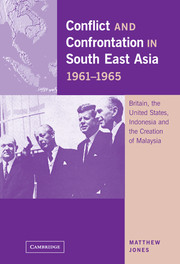 Conflict and Confrontation in South East Asia, 1961–1965
Conflict and Confrontation in South East Asia, 1961–1965 Book contents
- Frontmatter
- Contents
- List of maps
- Preface and acknowledgements
- List of abbreviations
- South East Asia
- Indonesia and Malaysia
- Introduction: Britain, the United States and the South East Asian setting
- Part I Build-up
- 1 The Kennedy Administration, Indonesia and the resolution of the West Irian crisis, 1961–1962
- 2 The Greater Malaysia scheme I: the move towards merger
- 3 The Greater Malaysia scheme II: the Cobbold Commission and the Borneo territories
- 4 Britain, Indonesia and Malaya: from West Irian to the Brunei revolt
- Part II Outbreak
- Part III Denouement
- Conclusion: The Western presence in South East Asia by the 1960s
- Bibliography
- Index
4 - Britain, Indonesia and Malaya: from West Irian to the Brunei revolt
Published online by Cambridge University Press: 25 July 2009
- Frontmatter
- Contents
- List of maps
- Preface and acknowledgements
- List of abbreviations
- South East Asia
- Indonesia and Malaysia
- Introduction: Britain, the United States and the South East Asian setting
- Part I Build-up
- 1 The Kennedy Administration, Indonesia and the resolution of the West Irian crisis, 1961–1962
- 2 The Greater Malaysia scheme I: the move towards merger
- 3 The Greater Malaysia scheme II: the Cobbold Commission and the Borneo territories
- 4 Britain, Indonesia and Malaya: from West Irian to the Brunei revolt
- Part II Outbreak
- Part III Denouement
- Conclusion: The Western presence in South East Asia by the 1960s
- Bibliography
- Index
Summary
That strong Indonesian opposition to the new Malaysian federation should emerge was not generally anticipated by either British or American officials, and little attention seems to have been devoted to likely Indonesian reactions, at least up to the autumn of 1962. Indeed, to some Western observers the settlement of the West Irian dispute in August 1962 was seen as a potential watershed, marking a turn away from the more assertive and unpredictable trends of Indonesian foreign policy that had been witnessed since Sukarno's introduction of Guided Democracy in the summer of 1959. Washington's efforts at mediation, and the rapid transfer of West Irian by the Dutch to UN Administration in preparation for the final handover to Indonesia in May 1963, had helped to remove one of the main irritants to US–Indonesian relations, along with an immediate source of regional tension and instability. Howard Jones, the US Ambassador in Jakarta, informed President Kennedy directly in October 1962 that ‘we had an opportunity today we had not had since 1950 to cement relations between the United States and Indonesia’. Certainly, many Administration officials were anxious that they should exploit the capital that the American role in resolving the dispute had supposedly accumulated in Jakarta, and as we have seen, Kennedy's National Security Action Memorandum 179 aimed to focus the bureaucracy on the goal of improving ties with Indonesia and working up aid programmes that could influence the regime in a pro-Western direction.
- Type
- Chapter
- Information
- Conflict and Confrontation in South East Asia, 1961–1965Britain, the United States, Indonesia and the Creation of Malaysia, pp. 98 - 122Publisher: Cambridge University PressPrint publication year: 2001


